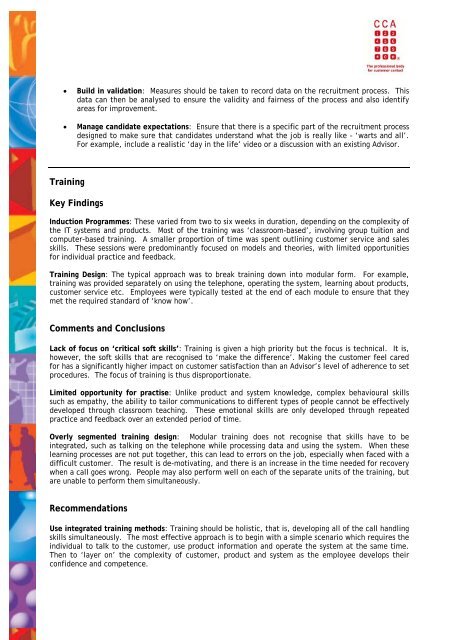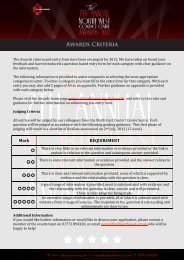Using Psychology to Get Contact Centres Right - CallNorthWest
Using Psychology to Get Contact Centres Right - CallNorthWest
Using Psychology to Get Contact Centres Right - CallNorthWest
You also want an ePaper? Increase the reach of your titles
YUMPU automatically turns print PDFs into web optimized ePapers that Google loves.
• Build in validation: Measures should be taken <strong>to</strong> record data on the recruitment process. Thisdata can then be analysed <strong>to</strong> ensure the validity and fairness of the process and also identifyareas for improvement.• Manage candidate expectations: Ensure that there is a specific part of the recruitment processdesigned <strong>to</strong> make sure that candidates understand what the job is really like – ‘warts and all’.For example, include a realistic ‘day in the life’ video or a discussion with an existing Advisor.TrainingKey FindingsInduction Programmes: These varied from two <strong>to</strong> six weeks in duration, depending on the complexity ofthe IT systems and products. Most of the training was ‘classroom-based’, involving group tuition andcomputer-based training. A smaller proportion of time was spent outlining cus<strong>to</strong>mer service and salesskills. These sessions were predominantly focused on models and theories, with limited opportunitiesfor individual practice and feedback.Training Design: The typical approach was <strong>to</strong> break training down in<strong>to</strong> modular form. For example,training was provided separately on using the telephone, operating the system, learning about products,cus<strong>to</strong>mer service etc. Employees were typically tested at the end of each module <strong>to</strong> ensure that theymet the required standard of ‘know how’.Comments and ConclusionsLack of focus on ‘critical soft skills’: Training is given a high priority but the focus is technical. It is,however, the soft skills that are recognised <strong>to</strong> ‘make the difference’. Making the cus<strong>to</strong>mer feel caredfor has a significantly higher impact on cus<strong>to</strong>mer satisfaction than an Advisor’s level of adherence <strong>to</strong> setprocedures. The focus of training is thus disproportionate.Limited opportunity for practise: Unlike product and system knowledge, complex behavioural skillssuch as empathy, the ability <strong>to</strong> tailor communications <strong>to</strong> different types of people cannot be effectivelydeveloped through classroom teaching. These emotional skills are only developed through repeatedpractice and feedback over an extended period of time.Overly segmented training design: Modular training does not recognise that skills have <strong>to</strong> beintegrated, such as talking on the telephone while processing data and using the system. When theselearning processes are not put <strong>to</strong>gether, this can lead <strong>to</strong> errors on the job, especially when faced with adifficult cus<strong>to</strong>mer. The result is de-motivating, and there is an increase in the time needed for recoverywhen a call goes wrong. People may also perform well on each of the separate units of the training, butare unable <strong>to</strong> perform them simultaneously.RecommendationsUse integrated training methods: Training should be holistic, that is, developing all of the call handlingskills simultaneously. The most effective approach is <strong>to</strong> begin with a simple scenario which requires theindividual <strong>to</strong> talk <strong>to</strong> the cus<strong>to</strong>mer, use product information and operate the system at the same time.Then <strong>to</strong> ‘layer on’ the complexity of cus<strong>to</strong>mer, product and system as the employee develops theirconfidence and competence.






